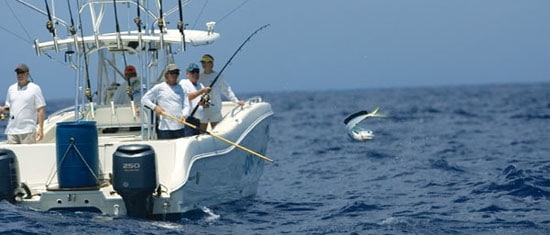
CAT BURGLARS: A mate aboard Captain Brian Cone’s catamaran, Contagious, prepares to snatch a dolphin-a gamefish that Cone has made his specialty.
Photo: Richard Gibson
If you don’t already know the name Brian Cone, you will soon-especially if you’re into catching dolphin. In the Florida Keys, where he’s been guiding since 1999, Cone is drawing comparisons to Tiger Woods: He’s young, he’s exciting and he dominates the dolphin grounds with the same passion and intensity that Woods shows on the golf course.
I first met Cone in 1996 after he graduated from Florida Southern College with a degree in marine biology. When it came to a career choice, fishing beat out science, and Cone began working as a full-time guide. Cone fishes inshore and offshore for most of the gamefish that roam Florida waters, but none as much as dolphin. These iridescent fighters quickly became Cone’s specialty, and he has the record to prove it.
“I’ve won more tournaments than I can count,” says Cone. “My best guess is 50 to 75, and I’ve placed second or third in at least 100 more. I like tournaments, but the cost of fuel makes it too expensive to fish some of them.”
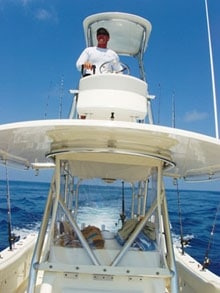
| |Cone often scouts for activity from the boat tower. Photo: Vin T. Sparano| With so many wins under his belt, I knew Cone had to have some secret slammer techniques. Last March, I asked him to take me fishing and give me lessons in hunting bulls.
Lesson 1: Bird Watching
March is the unofficial start of dolphin season in the Keys, but it doesn’t get red-hot until April, and then it runs through the summer months. Still, as we pulled away in Cone’s 33-foot World Cat, Contagious, he was convinced he could find some bulls. The twin 250 Yamahas hurried us through the three-mile run to the reef at Alligator Light in about ten minutes. Cone wanted at least 1,000 feet of water before we put the lines out, but he started looking for birds as soon as we hit the dropoff on the other side of the reef.
“Early in the spring, I look for frigate birds because the terns haven’t yet shown up in big numbers,” he explained. “I look for sooty terns flying high over the water. These birds are usually over bigger dolphin and working into the current, feeding on flying fish and squid-gourmet food for bull dolphin. That’s the big difference. The birds need to stay high over bigger dolphin because they swim in smaller packs and the terns don’t want to lose them. When you see birds swooping down on these larger baits, you can be sure dolphin are in the area. If you see birds working closer to the water, they’re usually feeding on small fish in the weeds.”
But some days there are no birds around, and when that happens many fishermen panic. So I asked Cone how he adjusts when he can’t find birds.
“Well, I don’t go home,” he said, laughing. “If I can’t find birds, I look for a scattered weedline in 1,000 to 3,000 feet of water and troll it. The larger, more continuous weedlines have probably already been worked over by other boats. If you see bubbles in the weedline, it’s a good sign that another boat has already been there.”
Lesson 2: The Perfect Tackle
It was a rare, nearly windless day, blowing only a few knots from the west.
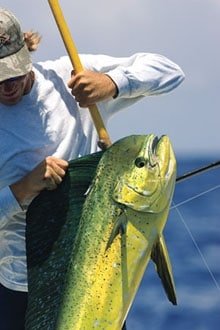
| |The captain gathers some bait near Alligator Light to hopefully bring some nice dolphin to gaff. Photo: Richard Gibson| We reached the Gulf Stream, which appeared as a distinct slick, without seeing any birds and only stopped long enough for my friend Joe McHugh to catch and release a cruising sailfish that ate a small feathered jig. Anglers Ralph DePonte and Tom Maher rounded out our crew.
When there’s no wind, Cone trolls first. He uses 30-pound tackle and six-foot, 80-pound leaders. But once he finds fish, he’ll switch to 15- or 30-pound spinning gear, because it makes casting baits easier. He ties a 40- or 50-pound leader to a four-foot doubled line tied with a Bimini twist on the lighter rods, and a 60- or 80-pound leader on the heavier tackle.
We put lures on the two flat lines about 75 feet behind the boat. Cone’s three favorite dolphin lures are a five-inch Mold Craft Super Chugger, a four-inch Ilander Tracker in blue-and-white and a four-inch P-Line squid in pink-purple-and-black.
“I get better bites on smaller lures and a better catch ratio, too, because the fish gets the entire lure in its mouth,” says Cone. “I sometimes use these small lures on my spinning tackle. It makes it easier to unhook a fish and cast the lure back into the school. And if the action gets hot, I’ll also pinch back the barb.”
On the outriggers, Cone sets two rigged ballyhoo-without plastic skirts-and runs the dead baits back 150 to 200 feet.
It was a rare, nearly windless day, blowing only a few knots from the west.
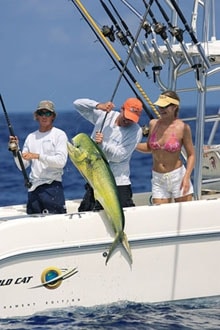
| | Photo: Richard Gibson| As for why Cone opts to drop the skirt, he says he prefers a more natural look.
“How often do you see a baitfish swimming around with a skirt on its nose?” he said. “They just don’t look right. I only use skirts and softheads in front of ballyhoo when I don’t have fresh bait, and I have to troll frozen ballyhoo that will wash out fast.”
Lesson 3: The Baiting Game
When the first dolphin is hooked, Cone drops the boat down to a low idle, keeping it in gear but moving just fast enough to keep the school close behind. That’s exactly what happened when we trolled past a piece of wood on the surface.
It’s common knowledge that any kind of floating debris attracts small baitfish and becomes a feeding station for bluewater fish, especially dolphin. So it came as no surprise when a dolphin came charging and nailed the Super Chugger squid on the flat line. We had several ballyhoo chunks ready because Cone wanted us to start chunking as soon as the school swam within range behind the boat. When we got that first fish in close, we could see more dolphin flashing in the water within easy casting reach.
These fish were ravenous, and it took only seconds to get another hookup on spinning tackle and ballyhoo chunks.
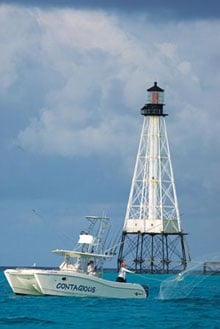
| | Photo: Richard Gibson| We kept one dolphin in the water and gaffed it only when we had another near the transom. We had boated five or six dolphin, including a 25-pound bull, when the school suddenly disappeared.
Cone says live bait works better for catching five- to 15-pound schoolies. But he generally prefers dead ballyhoo, flying fish and bonita or squid chunks, because you can set the hook more firmly with dead bait. Live bait may entice more fish, but dolphin will often feel the hook and tend to play with it rather than swallow it.
Lesson 4: stream scanning
Cone spends a good deal of his time on the boat in the tower, scanning for fish along weedlines. Visibility increases significantly the higher you go, and the power of the tower came into play as we continued to prowl for dolphin.
When it comes to searching for dolphin in the Gulf Stream, Cone believes the smaller dolphin feed with the flow because they don’t have the energy to fight the current and chase bait at the same time. The bigger, stronger dolphin, however, feed into the current. For this reason, when Cone hooks a big fish, he turns his boat into the current, where he knows more big dolphin will be feeding.
I missed a small boil on the surface, but Cone saw it. He spun the boat toward the activity, and I started to toss ballyhoo chunks. Almost instantly, a school of dolphin appeared, slashing the surface. With 15-pound spinning tackle, we cast baits into the school and hooked up instantly. After about ten minutes of cockpit chaos, we boated eight schoolies with a couple of 20-pounders thrown in.
After my successful day with Cone, it became clear how and why he’s made such a name for himself as one of the Keys’ premier dolphin captains.
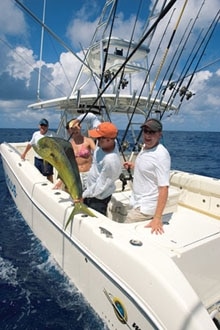
| | STAY RIGHT THERE: Cone (orange hat) often has ballyhoo chunks ready to keep a school of dolphin near the boat.| | Photo: Richard Gibson| We went fishing at a time before the season was in full swing and on a day when there were no birds, and he still put us on dolphin. And considering that Cone has less than ten years guiding experience to his credit, it’s easy to wonder where he picked up all of his slammer secrets.
“When I was younger, I learned a lot of my dolphin techniques from Dennis “Bogie” Bogan and Scott Stanczyk, two Keys captains who know how to go that extra mile and come back with record-book catches,” says Cone. “Scott, for example, nearly guided his nephew to a fly-line record with a 51-pound bull dolphin. I lived just down the street from Bogie, and I’d ride along as a spotter on his boat. I watched these captains, and I learned how to stay with the school and work the fish.”
When I asked Cone about the most important lesson he took from these captains, his response was simple and, after fishing with him on this particular day, not all that surprising. “Dolphin fishing,” he said after a second or two of thought, “is not just about looking for the birds.”
To catch some dolphin aboard the Contagious with Captain Brian Cone, call (305) 664-2278.









